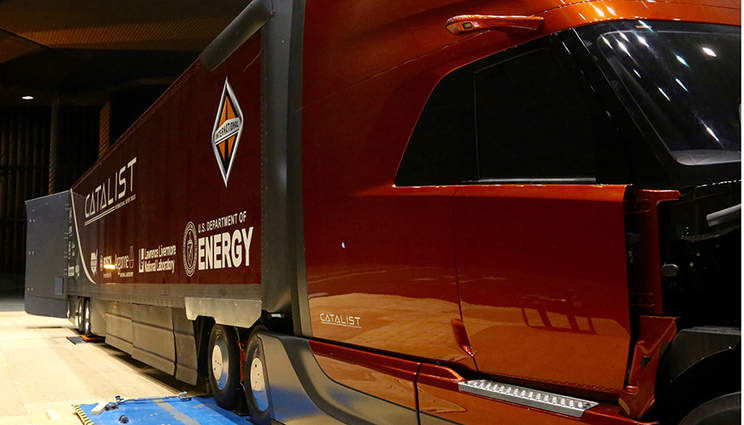Lab developed aerodynamic devices improve tractor trailer fuel efficiency
 (Download Image)
Lawrence Livermore National Laboratory researchers, as part of a Navistar SuperTruck I team, helped design a new type of tractor-trailer truck that significantly improves fuel economy.
(Download Image)
Lawrence Livermore National Laboratory researchers, as part of a Navistar SuperTruck I team, helped design a new type of tractor-trailer truck that significantly improves fuel economy.
Lawrence Livermore National Laboratory (LLNL) researchers, as part of a Navistar SuperTruck I team, helped design a new type of tractor-trailer truck that significantly improves fuel economy.
The new SuperTruck vehicle achieved 13 mpg on public roads and a 104 percent freight efficiency improvement. Forty-eight percent of this improvement comes from aerodynamic enhancements developed by LLNL and Navistar while the rest comes from engine efficiency, tire rolling resistance, light weighting and other advancements.
The trucking industry could potentially achieve fuel efficiency gains through aerodynamics developed by LLNL and Navistar that equate to 21 billion gallons of diesel fuel saved, 210 million tons of reduced carbon dioxide emissions and $52 billion saved at an average diesel price of $2.51 per gallon annually.
An interesting fact about class 8 heavy vehicles on the highway is that most of their engine output goes into overcoming aerodynamic drag and rolling resistance. To combat this loss, the LLNL team with the aid of experiments and computer simulations have developed new generic highly aerodynamic body shapes called Generic Speed Form (GSF) to significantly reduce drag.
Aerodynamic drag is caused from pressure differences around the vehicle. Major contributors to the drag are: the gap between tractor and trailer, the vehicle underbody and trailer wake.
"The LLNL GSF shapes have demonstrated a breakthrough in aerodynamic performance of heavy vehicles," said Kambiz Salari, an LLNL fluid dynamics researcher who heads the project. "We’re not only saving money, we are helping the environment by reducing carbon emissions."
The LLNL project is funded by the U.S. Department of Energy (DOE), Energy Efficiency and Renewable Energy (EERE), Vehicle Technologies Office (VTO) and Vehicle Systems (VS).
Salari and LLNL’s Jason Ortega, as part of Navistar’s SuperTruck I team, have helped to improve the aerodynamic design of the SuperTruck. The truck also has other fuel efficiency improvements, such as a more efficient engine, better rolling resistance tires, fewer tires and other equipment.
The team, in collaboration with Navistar, has performed scaled and full-scale tests at the Army's 7-foot by 10-foot wind tunnel and the Air Force's 80-foot by 120-foot wind tunnel at the National Full-Scale Aerodynamics Complex (NFAC) located at NASA Ames Research Center.
LLNL is providing guidance to the trucking industry to improve the fuel efficiency of class 8 tractor-trailers and tankers through enhanced aerodynamics. Partners for the SuperTruck I effort include Navistar, Wabash National, Bosch and Argonne National Laboratory.
Future plans include: continuing tractor-trailer integration design for improvement in aerodynamic drag and fuel economy; continued use of experiments to design a more advanced integrated tractor-trailer; performing scaled experiments to design and validate the performance of aerodynamic add-on devices for integrated tractor-trailers and tankers; investigating fuel economy benefits of truck platooning (similar to a convoy) in collaboration with the National Renewable Energy Laboratory; and continued coordination of industry participation to design the next generation of highly aerodynamic heavy vehicles.
Contact
 Anne M. Stark
Anne M. Stark
[email protected]
(925) 422-9799
Related Links
NavistarU.S. Department of Energy Energy Efficiency and Renewable Energy
National Full-Scale Aerodynamics Complex
Related Files
DownloadTags
EngineeringPhysical and Life Sciences
Featured Articles







